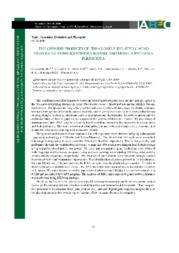The genome projects of the closely related cacao pathogens Moniliophthora roreri and Moniliophthora perniciosa.
The genome projects of the closely related cacao pathogens Moniliophthora roreri and Moniliophthora perniciosa.
Author(s): CARAZZOLLE, M. F.; COSTA, G. G. L.; HERAI, R. H.; R. JÚNIOR, O.; NASCIMENTO, L. C.; TEIXEIRA, P. J.; TIBURCIO, R. A.; MONDEGO, J. M. C.; PEREIRA, G. A. G.
Summary: The basidiomycetes Moniliophthora roreri and Moniliophthora perniciosa are the etiologic agents of the two most devastating diseases in cacao (Theobroma cacao ): frosty pod rot and the witches? broom, respectively. The species are very closely related and even hybrid cells have been previously obtained. In cacao, both species infect pods, causing necrosis, and M. perniciosa is also able to invade other tissues causing changes in plant metabolisms, such as hyperplasia and hypertrophy. In order to understand the molecular basis of these organisms, we sequenced the genome of these two species. We also obtained transcriptomic data (RNA-seq) in several different conditions including the interaction between cacao and both pathogens. This work reports a pipeline utilized to assembly and compare these genomes, and to identify differential gene expression between libraries. The genomic and transcriptomic sequences for both organisms were obtained using high-throughput sequencing technology (454/Roche and Solexa/Illumina). The Solexa and 454 reads were assembled into longer contigs using de novo assembler Velvet and Newbler, respectively. The hybrid assembly was performed through the combination of Solexa contigs and 454 contigs resulting in ?nal hybrid contigs using a pipeline developed in our group. Ab initio and comparative gene predictions were obtained with Augustus and Exonerate programs using previous training set (including RNA-seq data) and the closely related organisms, respectively. The ?nal set of gene models were obtained through a union between ab-initio and comparative approaches. The identi?cation of gene expressed in both pathogens, for each library, was obtained mapping the RNA-seq reads into the predicted gene models. In order to identify the gene expressed in T. cacao , the RNA-seq reads were mapped into transcriptome assembly of T. cacao. The transcriptome assembly was obtained using around 160.000 T. cacao ESTs available at NCBI and assembled by CAP3 program. The analysis of differential expressed genes between libraries was performed using DEG-seq package. The M. perniciosa genome project (http://www.lge.ibi.unicamp.br/vassoura) and M. roreri genome project (http://www.lge.ibi.unicamp.br/roreri) involve several Brazilian and international laboratories. The comparative genomics in the structure level, gene content level, and orthologous gene sequence can provide new insights that can help this community to increase efforts in cacao diseases investigation.
Publication year: 2010
Types of publication: Abstract in annals or event proceedings
Observation
Some of Embrapa's publications are published as ePub files. To read them, use or download one of the following free software options to your computer or mobile device. Android: Google Play Books; IOS: iBooks; Windows and Linux: Calibre.
Access other publications
Access the Agricultural Research Database (BDPA) to consult Embrapa's full library collection and records.
Visit Embrapa Bookstore to purchase books and other publications sold by Embrapa.

